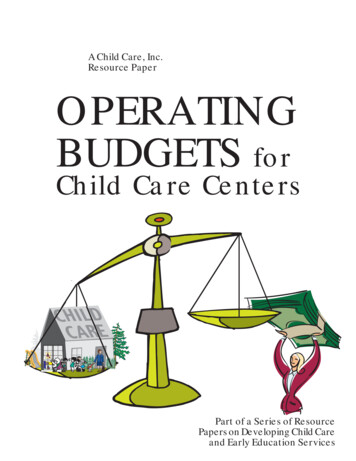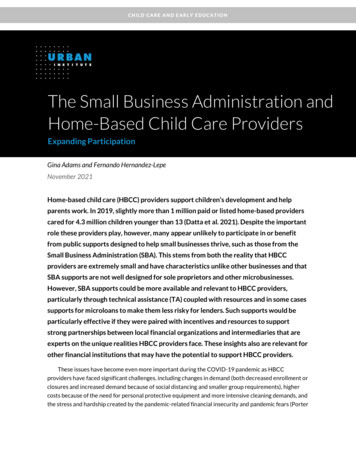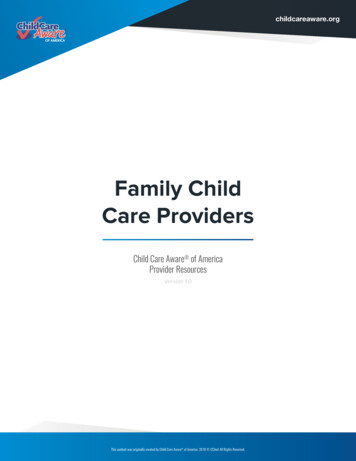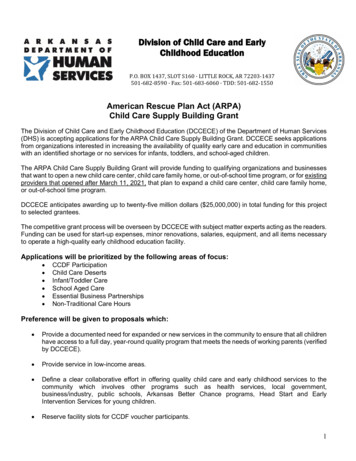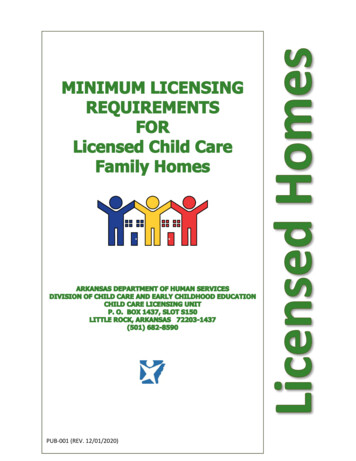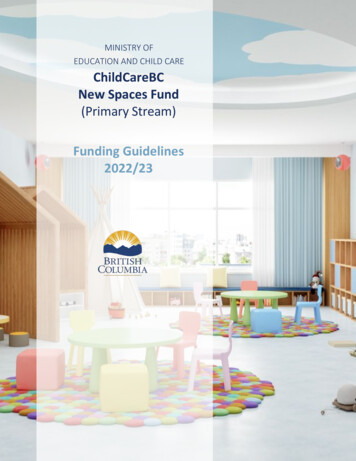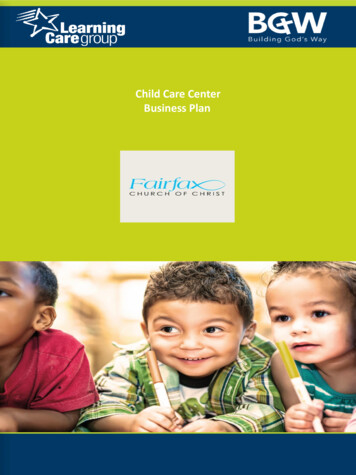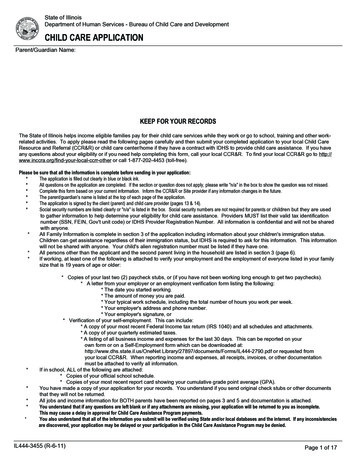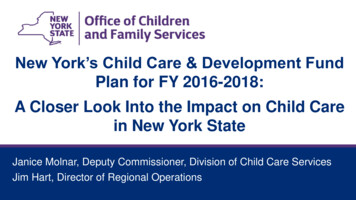
Transcription
New York’s Child Care & Development FundPlan for FY 2016-2018:A Closer Look Into the Impact on Child Carein New York StateJuly 20,Molnar,2016JaniceDeputy Commissioner, Division of Child Care ServicesJim Hart, Director of Regional Operations
July 20, 2016Overview of the Child Care andDevelopment Fund (CCDF) Plan The CCDF Plan the agreement between the leadagency and the federal government as to how CCDFprograms will be administered Lead agency OCFS 2 ½ year plan: FFY 2016-2018 (for the period June 1,2016 – September 30, 2018)2
July 20, 2016Timeline Draft Plan is posted to the OCFS website Public Hearings:o Rensselaer, January 26o Rochester, January 27o New York City, January 29 Comments integrated into draft Plan Final draft submitted to the federal Office of Child Careby March 13
July 20, 2016The Child Care and Development BlockGrant (CCDBG) Act of 2014 The CCDBG Act of 2014 reauthorized the Child Care andDevelopment Fund (CCDF) for the first time since 1996 Passed in Congress on Nov. 7, 2014 and was signed into law byPresident Obama on Nov. 19, 2014 The CCDF is a 5.3 billion block grant that provides funding tostates to improve the quality of child care and provide access to lowincome families In 2015, NYS’s CCDF allocation was 309 million CCDBG reauthorizes the CCDF through FY 20204
July 20, 20165Sections of the Plan Part 1: Leadership and Coordination Part 2: Family Engagement Part 3: Financial Assistance to Families Part 4: Equal Access Part 5: Health and Safety Standards and Monitoring Part 6: Child Care Workforce Part 7: Quality Improvement Part 8: Program Integrity
July 20, 2016Part 1: Leadership & Coordination CCDF leadershipCCDF policy decision authorityConsultation in the development of the CCDF PlanCoordination with partners to expand accessibility andcontinuity of careOptional use of combined fundsPublic-Private partnershipsCoordination with local or regional Child Care Resourceand Referral SystemsDisaster preparedness and response plan6
July 20, 2016Part 2: Family Engagement Child care financial assistance availability andapplication process Consumer and provider educationinformation/website for consumer education Information about the quality of child careproviders7
July 20, 20168Part 2: Website for Consumer es for Families.asp
July 20, 20169Child Care Options p
July 20, 2016Part 2: Unmet Requirements Research and best practices Policy on expulsion Access to developmentalscreenings Consumer Education Website10
July 20, 201611Part 2: Progress to DateThe Pyramid Model:Promoting Social and Emotional Competence and Addressing Challenging BehaviorTertiaryIntervention:Few ChildrenSecondaryPrevention:Some ChildrenUniversalPromotion:All Childrenhttp:/bit/ly/NYpyramid
July 20, 201612Part 2: Progress to DateDevelopmental screeningsOCFS continues to partner with the NYS Department ofHealth, Division of Family Health to: Develop communication to child care providers on theimportance of developmental screening Issue a guidance document to early childhood providerson the importance of early identification and earlyintervention services Implement a set of quality indicators to be incorporated inOCFS licensing visits
July 20, 2016Part 3: Financial Assistance to Families Increasing access for vulnerable children andfamilies Protection for working parents Family contribution to payment13
July 20, 2016Part 3: Unmet Requirements 12-month eligibility Graduated phase-out14
July 20, 201615Part 3: Improving access to homelesschildren and familiesPlan of action: Expand definition of protective services Provide child care subsidies to support families for at least threemonths of job search Waive family fee for homeless families. Revisit the enhanced subsidy rate for providing child care during nontraditional hours, New enhanced subsidy rate to incentivize providers to serve childrenwho are homeless Broaden the scope of one of the milestones of our performance-basedcontracts with CCR&Rs to allow them to do targetedoutreach to homeless shelters
July 20, 2016Part 3: Professional Development toimprove access to homeless children andfamilies Develop a statewide live videoconference training forproviders in trauma-informed approaches tosupporting child development for children who arehomeless or experiencing other traumatic events Offer relevant Head Start training (both online and inperson) to child care providers serving children whoare homeless16
July 20, 2016Part 4: Equal AccessMarket Rates Survey was conducted in the spring of2015 42% response rate New market rates will be issued byJune 1, 201617
July 20, 2016Part 4: Unmet Requirements Payment practicesooPaying for absences and program closure daysChild Care Time and Attendance (CCTA) Supply buildingooooInfants and toddlersChildren with disabilitiesNon-traditional hoursHomeless children Child Care Mapping Research Project (CCMRP)18
July 20, 2016Part 5: Health & Safety Standards andMonitoring Licensing and monitoring policiesand practices Criminal background checks19
July 20, 2016Part 5: Progress to Date Pre-licensure inspection (already NYS practice) Child Care standards address appropriate ratios betweenthe number of children and the number of providers andgroup size Required qualifications for providers are appropriate toeach type of setting Policies and practices to ensure that providers for childrenreceiving assistance and their facilities comply withapplicable state or local licensing and health and safetyrequirements20
July 20, 2016Part 5: Unmet Requirements Establish health and safety requirements for providersserving children receiving CCDF assistance relating tomatters included in the topics listed below, and have preservice or orientation training requirements that addressthese health and safety topics:oooPrevention and control of infectious diseases (includingimmunization)Prevention of SIDS and use of safe sleeping practicesAdministration of medication, consistent with standards forparental consent21
July 20, 2016Part 5: Unmet Requirements (cont’d)oooooooPrevention of and response to emergencies due to food andallergic reactionsBuilding and physical premises safetyPrevention of shaken baby syndrome and abusive head traumaEmergency preparedness and response planning foremergencies resulting from a natural disaster, or a man-causedeventHandling and storage of hazardous materials and theappropriate disposal of bio contaminantsPrecautions in transporting children (if applicable)First aid and cardiopulmonary resuscitation (CPR) certification22
July 20, 2016Part 5: Unmet Requirements (cont’d) Require licensing inspectors to perform one unannouncedinspection Annual monitoring visit of license-exempt CCDF providers Ratio of licensing inspectors Annual, unannounced full inspections of all facilities(including legally-exempt) Inspection results posted publicly online Online information regarding major substantiatedcomplaints; number of deaths, serious injuries,and instances of substantiated child abuse23
July 20, 2016Part 5: Criminal Background Checks National Crime Information CenterFBI fingerprint checkNational Sex Offender RegistryState criminal and sex offender registry in each stateapplicant has resided in over the past 5 years (includingNYS) Child abuse and neglect registry in each state applicanthas resided in over the past 5 years (including NYS)24
July 20, 2016Part 6: Child Care Workforce Mandatory pre-service/orientation healthand safety training for all child care staff New list of federal training topics forprofessional development Include ongoing, annual training and aprogression of professional development Training requirements include legallyexempt providers25
July 20, 2016Part 6: Progress to Date Training and professional developmentrequirements for regulated providers andprograms Policies and practices to strengthen provider’sbusiness practices Early learning and development guidelinesappropriate for children from birth to kindergartenentry26
July 20, 201627Part 7: Quality Improvement Activities to improve the quality of child care services Quality rating and improvement system Improving the supply and quality of child care programs and services forinfants and toddlers Child care resource and referral Facilitating compliance with state standards Evaluating and assessing the quality and effectiveness of child careprograms and services Accreditation support Program standards Other quality improvement activities
July 20, 201628Part 7: Progress to DateNYS’s Overarching Goals for Quality Improvement:1. Supporting the training and professional development of the childcare workforce.2. Improving the quality of child care programs and services forinfants and toddlers by supporting seven infant/toddler regionalresource centers throughout the state.3. Supporting a statewide network of 36 CCR&R agencies, alongwith the Early Care and Learning Council, which is themembership organization for CCR&Rs in New York State.
July 20, 2016Part 7: Progress to Date (cont’d)4. Supporting compliance with state requirements for licensing,inspection, monitoring, training, and health and safety .5. Supporting providers in the voluntary pursuit of accreditationthrough the Educational Incentive Program.6. Supporting the development or adoption of high-quality programand regulatory standards related to health, mental health,nutrition, physical activity, and physical development.29
July 20, 2016Part 7: Progress to Date (cont’d)Developing a system of quality indicatorsfor regulated child care programs Dr. Richard Fiene, Director, ResearchInstitute for Key Indicators Differential Monitoring – using the keyindicator methodology process toidentify the strongest predictors of fullregulatory compliance30
July 20, 2016Part 7:Increased Focus on Quality Improvement Phases in an increase in minimum qualityset-aside spending from 4% to 9% over a5-year period (NYS already meets thisrequirement.) Begins in Federal FY 2016 In addition, requires states to spend aminimum of 3% to improve the quality ofcare for infants and toddlers States must establish outcome measuresand evaluate progress of quality activities31
July 20, 201632Part 7: New List of Quality ActivitiesStates must spend quality funds on at least one of the following QualityActivities: Training and professionaldevelopment Early learning and developmentguidelines Tiered quality rating system Improving quality of services forinfants and toddlers Child care resource and referralservices Licensing and health and safetyrequirements Quality evaluation Accreditation Program standards Other measurable quality activitiesas determined by the state
July 20, 2016The Road Ahead Analyzed public commentIntegrated some of the recommendationsSubmitted the PlanRequested waivers and extensionsPlan approval by June 1New federal regulations expected in the summer33
July 20, 201634Questions?Thank you!
July 20, 201635For information aboutChild Care inNew York are/default.asp
July 20, 2016 3 Timeline Draft Plan is posted to the OCFS website Public Hearings: o Rensselaer, January 26 o Rochester, January 27 o New York City, January 29 Comments integrated into draft Plan Final draft submitted to the federal Office of Child Care by March 1

